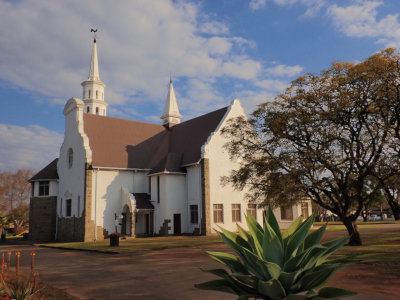The Dutch Reformed Church in Piet Retief: An Architectural and Historical Marvel
Nestled in the heart of Piet Retief stands not only a monument of stone and mortar but also a testament to history, faith, and architectural genius: The Dutch Reformed Church. This iconic structure, which stands tall and commanding, traces its origins back to the late 19th century and occupies a central place in Piet Retief's rich tapestry of history.
On 14 April 1888, a momentous decision was taken. The Piet Retief congregation decided to carve its own path, separating from its mother congregation in Wakkerstroom. This marked a significant new chapter in the church's evolution, one that saw the rise of several church buildings over successive years.
The initial church edifice was simple yet sturdy. Built primarily from stone and sod, it featured a traditional thatched roof. This structure was symbolic of the community's unwavering faith and dedication to their congregation. Although basic in its design, it laid the foundation for the church's future growth.
By 1893, the need for a newer, larger church became apparent. The next church was erected at a prime location, right in the town's central square. However, this building presented its own challenges. Its slate walls had a tendency to absorb moisture, making it less than ideal for enduring the elements.
Eager for a more majestic and functional church, the congregation began searching for modern architectural designs. Their quest ended with the adoption of designs by the esteemed architect, Gerard Moerdyk. With a clear vision and Moerdyk's blueprints, the congregation embarked on a new construction phase in 1921.
Built at a cost of £15000, the church was not only a marvel in terms of its architecture but also in its budgeting. The final costs came in £600 under budget, a noteworthy achievement. This grand edifice, clad in exquisite sandstone sourced from General Kemp's farm near Piet Retief, could accommodate 1200 worshippers upon its completion. The church's inauguration was a grand affair, with Dr. Bosman from Pretoria presiding over the ceremonies on Saturday, 21 October 1922.
By 1990, the church's prominence and historical significance were firmly established. On 21 December of that year, the building was officially declared a monument, etching its place not just in history, but also in the hearts and minds of Piet Retief's inhabitants.
The Dutch Reformed Church in Piet Retief stands as more than just a place of worship. It narrates a tale of dedication, unwavering faith, and unparalleled architectural vision. With its rich history stretching over a century, the church continues to be a beacon of Piet Retief's cultural and historical legacy, underscoring the tenacity and resilience of its congregation.
